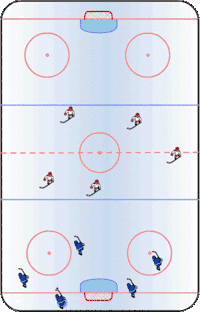Neutral zone trap
The neutral zone trap (often referred to as simply the trap) is a defensive strategy used in ice hockey to prevent an opposing team from proceeding through the neutral zone (the area between the blue lines) and to force turnovers. The strategy is generally used to level the playing field for teams that are not as offensively talented as their opponents, although the trap can also be used by teams simply looking to protect a lead late in the game. The trap was innovated by the Toronto Maple Leafs in the 1920s and 1930s but became the defensive scheme for most coaches during the late 90s and early 2000s—known as the "Dead Puck era"—as a direct result of the success seen by the New Jersey Devils under the coaching of Jacques Lemaire; the Devils won three Stanley Cup championships during this era (in 1995, 2000, and 2003). Lemaire utilized the trap that was employed by the Montreal Canadiens under his coach Scotty Bowman.

The most recognizable implementation of the trap sees the defense stationing four of their players in the neutral zone and one forechecker in the offensive zone. As the offensive team starts to move up the ice, the forechecker (generally the center) will cut off passing lanes to other offensive players by staying in the middle of the ice, forcing the puck carrier to either sideboard. The defensive wingers—typically placed on or near the red line—will be positioned by the boards to challenge the puck carrier, prevent passing, or even keep opponents from moving through. The two defencemen who are positioned on or near the blue lines are the last defence, and must stall the opposition long enough for the wingers to reset themselves and continue the trap.
The trap has been widely criticized for reducing scoring. It has, however, proven to be very effective, especially in the playoffs; most recently, the Washington Capitals employed the neutral zone trap to great effect during their 2018 Stanley Cup run.[1] During the 2004–05 NHL lockout, serious discussion about opening the game to offense was held between the NHL and NHL Players Association (NHLPA). Because it is easier to trap when engaging in obstruction and restraining fouls, such as hooking and holding, which slow the progress of faster players who can evade the trapping team, the NHL ordered officials to call every obstruction penalty, regardless of circumstance. The prohibition on two-line passes from behind a team's blue line to the other side of the red line was also lifted. Long passes are one method for breaking out of the trap, as it avoids the need to navigate through defenders in the neutral zone, although it has high rates of turnovers. The NHL also implemented a “Goalkeeper’s Restricted Area”, a trapezoidal area behind the net outside of which goalies cannot play the puck if they are behind the goal line. This allows offenses to more effectively dump the puck past the trap into the corners. Defensive minded teams have reverted to a "third man high" 1–3–1 system where only two offensive players will commit down low, allowing the third to join the defence and impede progress across the blue line.
References
- Whyno, Stephen. "Capitals' suffocating pressure frustrating Golden Knights in Stanley Cup Final". baltimoresun.com. Retrieved 2018-10-23.